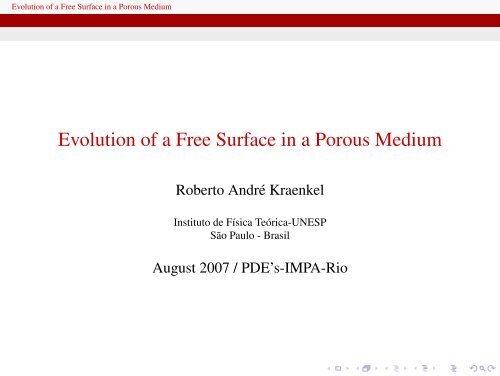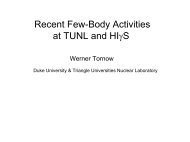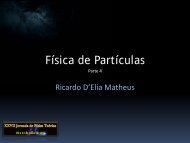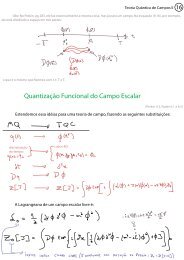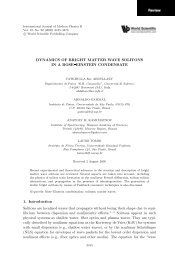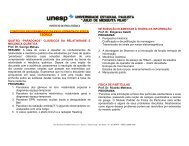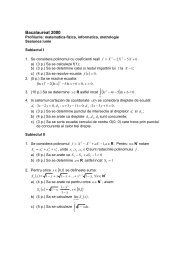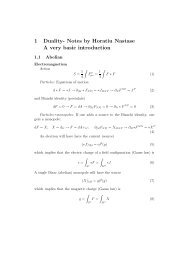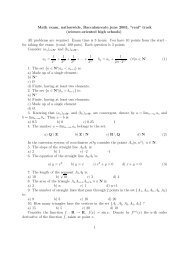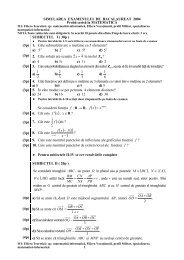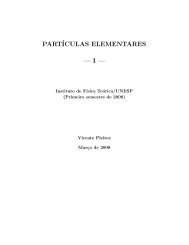Evolution of a Free Surface in a Porous Medium - Instituto de FÃsica ...
Evolution of a Free Surface in a Porous Medium - Instituto de FÃsica ...
Evolution of a Free Surface in a Porous Medium - Instituto de FÃsica ...
Create successful ePaper yourself
Turn your PDF publications into a flip-book with our unique Google optimized e-Paper software.
<strong>Evolution</strong> <strong>of</strong> a <strong>Free</strong> <strong>Surface</strong> <strong>in</strong> a <strong>Porous</strong> <strong>Medium</strong><br />
<strong>Evolution</strong> <strong>of</strong> a <strong>Free</strong> <strong>Surface</strong> <strong>in</strong> a <strong>Porous</strong> <strong>Medium</strong><br />
Roberto André Kraenkel<br />
<strong>Instituto</strong> <strong>de</strong> Física Teórica-UNESP<br />
São Paulo - Brasil<br />
August 2007 / PDE’s-IMPA-Rio
<strong>Evolution</strong> <strong>of</strong> a <strong>Free</strong> <strong>Surface</strong> <strong>in</strong> a <strong>Porous</strong> <strong>Medium</strong><br />
Overview<br />
Un<strong>de</strong>rground water
<strong>Evolution</strong> <strong>of</strong> a <strong>Free</strong> <strong>Surface</strong> <strong>in</strong> a <strong>Porous</strong> <strong>Medium</strong><br />
Overview<br />
Un<strong>de</strong>rground water<br />
<strong>Free</strong> <strong>Surface</strong> <strong>Evolution</strong> <strong>in</strong> <strong>Porous</strong> <strong>Medium</strong>: sett<strong>in</strong>g the problem
<strong>Evolution</strong> <strong>of</strong> a <strong>Free</strong> <strong>Surface</strong> <strong>in</strong> a <strong>Porous</strong> <strong>Medium</strong><br />
Overview<br />
Un<strong>de</strong>rground water<br />
<strong>Free</strong> <strong>Surface</strong> <strong>Evolution</strong> <strong>in</strong> <strong>Porous</strong> <strong>Medium</strong>: sett<strong>in</strong>g the problem<br />
Well-known results
<strong>Evolution</strong> <strong>of</strong> a <strong>Free</strong> <strong>Surface</strong> <strong>in</strong> a <strong>Porous</strong> <strong>Medium</strong><br />
Overview<br />
Un<strong>de</strong>rground water<br />
<strong>Free</strong> <strong>Surface</strong> <strong>Evolution</strong> <strong>in</strong> <strong>Porous</strong> <strong>Medium</strong>: sett<strong>in</strong>g the problem<br />
Well-known results<br />
Exact equation
<strong>Evolution</strong> <strong>of</strong> a <strong>Free</strong> <strong>Surface</strong> <strong>in</strong> a <strong>Porous</strong> <strong>Medium</strong><br />
Overview<br />
Un<strong>de</strong>rground water<br />
<strong>Free</strong> <strong>Surface</strong> <strong>Evolution</strong> <strong>in</strong> <strong>Porous</strong> <strong>Medium</strong>: sett<strong>in</strong>g the problem<br />
Well-known results<br />
Exact equation<br />
Conclusions
<strong>Evolution</strong> <strong>of</strong> a <strong>Free</strong> <strong>Surface</strong> <strong>in</strong> a <strong>Porous</strong> <strong>Medium</strong><br />
Un<strong>de</strong>rground water<br />
Un<strong>de</strong>rground water<br />
◮ Water that lies below the surface <strong>of</strong> the Earth
<strong>Evolution</strong> <strong>of</strong> a <strong>Free</strong> <strong>Surface</strong> <strong>in</strong> a <strong>Porous</strong> <strong>Medium</strong><br />
Un<strong>de</strong>rground water<br />
Un<strong>de</strong>rground water<br />
◮ Water that lies below the surface <strong>of</strong> the Earth<br />
◮ The un<strong>de</strong>rground is mo<strong>de</strong>led as be<strong>in</strong>g an aggregation <strong>of</strong> particles<br />
with pores between them;
<strong>Evolution</strong> <strong>of</strong> a <strong>Free</strong> <strong>Surface</strong> <strong>in</strong> a <strong>Porous</strong> <strong>Medium</strong><br />
Un<strong>de</strong>rground water<br />
Un<strong>de</strong>rground water<br />
◮ Water that lies below the surface <strong>of</strong> the Earth<br />
◮ The un<strong>de</strong>rground is mo<strong>de</strong>led as be<strong>in</strong>g an aggregation <strong>of</strong> particles<br />
with pores between them;<br />
◮ Water can flow through these pores.
<strong>Evolution</strong> <strong>of</strong> a <strong>Free</strong> <strong>Surface</strong> <strong>in</strong> a <strong>Porous</strong> <strong>Medium</strong><br />
Un<strong>de</strong>rground water<br />
Un<strong>de</strong>rground water<br />
◮ Water that lies below the surface <strong>of</strong> the Earth<br />
◮ The un<strong>de</strong>rground is mo<strong>de</strong>led as be<strong>in</strong>g an aggregation <strong>of</strong> particles<br />
with pores between them;<br />
◮ Water can flow through these pores.<br />
◮ This flow will be consi<strong>de</strong>red lam<strong>in</strong>ar.
<strong>Evolution</strong> <strong>of</strong> a <strong>Free</strong> <strong>Surface</strong> <strong>in</strong> a <strong>Porous</strong> <strong>Medium</strong><br />
Un<strong>de</strong>rground water<br />
Un<strong>de</strong>rground water<br />
◮ Water that lies below the surface <strong>of</strong> the Earth<br />
◮ The un<strong>de</strong>rground is mo<strong>de</strong>led as be<strong>in</strong>g an aggregation <strong>of</strong> particles<br />
with pores between them;<br />
◮ Water can flow through these pores.<br />
◮ This flow will be consi<strong>de</strong>red lam<strong>in</strong>ar.<br />
◮ The medium is saturated <strong>of</strong> water( the pore space is filled with<br />
water)
<strong>Evolution</strong> <strong>of</strong> a <strong>Free</strong> <strong>Surface</strong> <strong>in</strong> a <strong>Porous</strong> <strong>Medium</strong><br />
Un<strong>de</strong>rground water<br />
Un<strong>de</strong>rground water<br />
◮ Water that lies below the surface <strong>of</strong> the Earth<br />
◮ The un<strong>de</strong>rground is mo<strong>de</strong>led as be<strong>in</strong>g an aggregation <strong>of</strong> particles<br />
with pores between them;<br />
◮ Water can flow through these pores.<br />
◮ This flow will be consi<strong>de</strong>red lam<strong>in</strong>ar.<br />
◮ The medium is saturated <strong>of</strong> water( the pore space is filled with<br />
water) up to a certa<strong>in</strong> constant-pressure surface,
<strong>Evolution</strong> <strong>of</strong> a <strong>Free</strong> <strong>Surface</strong> <strong>in</strong> a <strong>Porous</strong> <strong>Medium</strong><br />
Un<strong>de</strong>rground water<br />
Un<strong>de</strong>rground water<br />
◮ Water that lies below the surface <strong>of</strong> the Earth<br />
◮ The un<strong>de</strong>rground is mo<strong>de</strong>led as be<strong>in</strong>g an aggregation <strong>of</strong> particles<br />
with pores between them;<br />
◮ Water can flow through these pores.<br />
◮ This flow will be consi<strong>de</strong>red lam<strong>in</strong>ar.<br />
◮ The medium is saturated <strong>of</strong> water( the pore space is filled with<br />
water) up to a certa<strong>in</strong> constant-pressure surface,<br />
◮ This is called a piezometric surface;
<strong>Evolution</strong> <strong>of</strong> a <strong>Free</strong> <strong>Surface</strong> <strong>in</strong> a <strong>Porous</strong> <strong>Medium</strong><br />
Un<strong>de</strong>rground water<br />
Un<strong>de</strong>rground water<br />
◮ Water that lies below the surface <strong>of</strong> the Earth<br />
◮ The un<strong>de</strong>rground is mo<strong>de</strong>led as be<strong>in</strong>g an aggregation <strong>of</strong> particles<br />
with pores between them;<br />
◮ Water can flow through these pores.<br />
◮ This flow will be consi<strong>de</strong>red lam<strong>in</strong>ar.<br />
◮ The medium is saturated <strong>of</strong> water( the pore space is filled with<br />
water) up to a certa<strong>in</strong> constant-pressure surface,<br />
◮ This is called a piezometric surface;<br />
◮ Above this surface, pores are partially filled with water.
<strong>Evolution</strong> <strong>of</strong> a <strong>Free</strong> <strong>Surface</strong> <strong>in</strong> a <strong>Porous</strong> <strong>Medium</strong><br />
Un<strong>de</strong>rground water<br />
Un<strong>de</strong>rground water<br />
◮ Water that lies below the surface <strong>of</strong> the Earth<br />
◮ The un<strong>de</strong>rground is mo<strong>de</strong>led as be<strong>in</strong>g an aggregation <strong>of</strong> particles<br />
with pores between them;<br />
◮ Water can flow through these pores.<br />
◮ This flow will be consi<strong>de</strong>red lam<strong>in</strong>ar.<br />
◮ The medium is saturated <strong>of</strong> water( the pore space is filled with<br />
water) up to a certa<strong>in</strong> constant-pressure surface,<br />
◮ This is called a piezometric surface;<br />
◮ Above this surface, pores are partially filled with water.<br />
◮ We will only consi<strong>de</strong>r a medium that is:
<strong>Evolution</strong> <strong>of</strong> a <strong>Free</strong> <strong>Surface</strong> <strong>in</strong> a <strong>Porous</strong> <strong>Medium</strong><br />
Un<strong>de</strong>rground water<br />
Un<strong>de</strong>rground water<br />
◮ Water that lies below the surface <strong>of</strong> the Earth<br />
◮ The un<strong>de</strong>rground is mo<strong>de</strong>led as be<strong>in</strong>g an aggregation <strong>of</strong> particles<br />
with pores between them;<br />
◮ Water can flow through these pores.<br />
◮ This flow will be consi<strong>de</strong>red lam<strong>in</strong>ar.<br />
◮ The medium is saturated <strong>of</strong> water( the pore space is filled with<br />
water) up to a certa<strong>in</strong> constant-pressure surface,<br />
◮ This is called a piezometric surface;<br />
◮ Above this surface, pores are partially filled with water.<br />
◮ We will only consi<strong>de</strong>r a medium that is:<br />
◮ “constant”, that is, there is no movement <strong>of</strong> the material that<br />
composes it;
<strong>Evolution</strong> <strong>of</strong> a <strong>Free</strong> <strong>Surface</strong> <strong>in</strong> a <strong>Porous</strong> <strong>Medium</strong><br />
Un<strong>de</strong>rground water<br />
Un<strong>de</strong>rground water<br />
◮ Water that lies below the surface <strong>of</strong> the Earth<br />
◮ The un<strong>de</strong>rground is mo<strong>de</strong>led as be<strong>in</strong>g an aggregation <strong>of</strong> particles<br />
with pores between them;<br />
◮ Water can flow through these pores.<br />
◮ This flow will be consi<strong>de</strong>red lam<strong>in</strong>ar.<br />
◮ The medium is saturated <strong>of</strong> water( the pore space is filled with<br />
water) up to a certa<strong>in</strong> constant-pressure surface,<br />
◮ This is called a piezometric surface;<br />
◮ Above this surface, pores are partially filled with water.<br />
◮ We will only consi<strong>de</strong>r a medium that is:<br />
◮ “constant”, that is, there is no movement <strong>of</strong> the material that<br />
composes it;<br />
◮ homogeneous
<strong>Evolution</strong> <strong>of</strong> a <strong>Free</strong> <strong>Surface</strong> <strong>in</strong> a <strong>Porous</strong> <strong>Medium</strong><br />
Un<strong>de</strong>rground water<br />
Un<strong>de</strong>rground water<br />
◮ Water that lies below the surface <strong>of</strong> the Earth<br />
◮ The un<strong>de</strong>rground is mo<strong>de</strong>led as be<strong>in</strong>g an aggregation <strong>of</strong> particles<br />
with pores between them;<br />
◮ Water can flow through these pores.<br />
◮ This flow will be consi<strong>de</strong>red lam<strong>in</strong>ar.<br />
◮ The medium is saturated <strong>of</strong> water( the pore space is filled with<br />
water) up to a certa<strong>in</strong> constant-pressure surface,<br />
◮ This is called a piezometric surface;<br />
◮ Above this surface, pores are partially filled with water.<br />
◮ We will only consi<strong>de</strong>r a medium that is:<br />
◮ “constant”, that is, there is no movement <strong>of</strong> the material that<br />
composes it;<br />
◮ homogeneous<br />
◮ We will consi<strong>de</strong>r a macroscopic <strong>de</strong>scription <strong>of</strong> the flow.
<strong>Evolution</strong> <strong>of</strong> a <strong>Free</strong> <strong>Surface</strong> <strong>in</strong> a <strong>Porous</strong> <strong>Medium</strong><br />
Un<strong>de</strong>rground water<br />
Un<strong>de</strong>rground water<br />
◮ Water that lies below the surface <strong>of</strong> the Earth<br />
◮ The un<strong>de</strong>rground is mo<strong>de</strong>led as be<strong>in</strong>g an aggregation <strong>of</strong> particles<br />
with pores between them;<br />
◮ Water can flow through these pores.<br />
◮ This flow will be consi<strong>de</strong>red lam<strong>in</strong>ar.<br />
◮ The medium is saturated <strong>of</strong> water( the pore space is filled with<br />
water) up to a certa<strong>in</strong> constant-pressure surface,<br />
◮ This is called a piezometric surface;<br />
◮ Above this surface, pores are partially filled with water.<br />
◮ We will only consi<strong>de</strong>r a medium that is:<br />
◮ “constant”, that is, there is no movement <strong>of</strong> the material that<br />
composes it;<br />
◮ homogeneous<br />
◮ We will consi<strong>de</strong>r a macroscopic <strong>de</strong>scription <strong>of</strong> the flow.<br />
◮ Our porous medium is boun<strong>de</strong>d by below by an impermeable<br />
bottom.
<strong>Evolution</strong> <strong>of</strong> a <strong>Free</strong> <strong>Surface</strong> <strong>in</strong> a <strong>Porous</strong> <strong>Medium</strong><br />
Un<strong>de</strong>rground water<br />
Un<strong>de</strong>rground water<br />
◮ Water that lies below the surface <strong>of</strong> the Earth<br />
◮ The un<strong>de</strong>rground is mo<strong>de</strong>led as be<strong>in</strong>g an aggregation <strong>of</strong> particles<br />
with pores between them;<br />
◮ Water can flow through these pores.<br />
◮ This flow will be consi<strong>de</strong>red lam<strong>in</strong>ar.<br />
◮ The medium is saturated <strong>of</strong> water( the pore space is filled with<br />
water) up to a certa<strong>in</strong> constant-pressure surface,<br />
◮ This is called a piezometric surface;<br />
◮ Above this surface, pores are partially filled with water.<br />
◮ We will only consi<strong>de</strong>r a medium that is:<br />
◮ “constant”, that is, there is no movement <strong>of</strong> the material that<br />
composes it;<br />
◮ homogeneous<br />
◮ We will consi<strong>de</strong>r a macroscopic <strong>de</strong>scription <strong>of</strong> the flow.<br />
◮ Our porous medium is boun<strong>de</strong>d by below by an impermeable<br />
bottom.
<strong>Evolution</strong> <strong>of</strong> a <strong>Free</strong> <strong>Surface</strong> <strong>in</strong> a <strong>Porous</strong> <strong>Medium</strong><br />
<strong>Free</strong> <strong>Surface</strong> <strong>Evolution</strong> <strong>in</strong> <strong>Porous</strong> <strong>Medium</strong>: sett<strong>in</strong>g the problem<br />
Sett<strong>in</strong>g the problem
<strong>Evolution</strong> <strong>of</strong> a <strong>Free</strong> <strong>Surface</strong> <strong>in</strong> a <strong>Porous</strong> <strong>Medium</strong><br />
<strong>Free</strong> <strong>Surface</strong> <strong>Evolution</strong> <strong>in</strong> <strong>Porous</strong> <strong>Medium</strong>: sett<strong>in</strong>g the problem<br />
Sett<strong>in</strong>g the problem<br />
◮ The problem is to study the propagation <strong>of</strong> a disturbance on the<br />
surface <strong>of</strong> a fluid totally immersed <strong>in</strong> a porous medium.
<strong>Evolution</strong> <strong>of</strong> a <strong>Free</strong> <strong>Surface</strong> <strong>in</strong> a <strong>Porous</strong> <strong>Medium</strong><br />
<strong>Free</strong> <strong>Surface</strong> <strong>Evolution</strong> <strong>in</strong> <strong>Porous</strong> <strong>Medium</strong>: sett<strong>in</strong>g the problem<br />
Sett<strong>in</strong>g the problem<br />
◮ The problem is to study the propagation <strong>of</strong> a disturbance on the<br />
surface <strong>of</strong> a fluid totally immersed <strong>in</strong> a porous medium.<br />
◮ We want to get the equation govern<strong>in</strong>g the evolution <strong>of</strong> this<br />
disturbance.
<strong>Evolution</strong> <strong>of</strong> a <strong>Free</strong> <strong>Surface</strong> <strong>in</strong> a <strong>Porous</strong> <strong>Medium</strong><br />
<strong>Free</strong> <strong>Surface</strong> <strong>Evolution</strong> <strong>in</strong> <strong>Porous</strong> <strong>Medium</strong>: sett<strong>in</strong>g the problem<br />
Sett<strong>in</strong>g the problem<br />
◮ The problem is to study the propagation <strong>of</strong> a disturbance on the<br />
surface <strong>of</strong> a fluid totally immersed <strong>in</strong> a porous medium.<br />
◮ We want to get the equation govern<strong>in</strong>g the evolution <strong>of</strong> this<br />
disturbance.<br />
◮ Ma<strong>in</strong> Application:
<strong>Evolution</strong> <strong>of</strong> a <strong>Free</strong> <strong>Surface</strong> <strong>in</strong> a <strong>Porous</strong> <strong>Medium</strong><br />
<strong>Free</strong> <strong>Surface</strong> <strong>Evolution</strong> <strong>in</strong> <strong>Porous</strong> <strong>Medium</strong>: sett<strong>in</strong>g the problem<br />
Sett<strong>in</strong>g the problem<br />
◮ The problem is to study the propagation <strong>of</strong> a disturbance on the<br />
surface <strong>of</strong> a fluid totally immersed <strong>in</strong> a porous medium.<br />
◮ We want to get the equation govern<strong>in</strong>g the evolution <strong>of</strong> this<br />
disturbance.<br />
◮ Ma<strong>in</strong> Application:<br />
◮ Groundwater
<strong>Evolution</strong> <strong>of</strong> a <strong>Free</strong> <strong>Surface</strong> <strong>in</strong> a <strong>Porous</strong> <strong>Medium</strong><br />
<strong>Free</strong> <strong>Surface</strong> <strong>Evolution</strong> <strong>in</strong> <strong>Porous</strong> <strong>Medium</strong>: sett<strong>in</strong>g the problem<br />
Sett<strong>in</strong>g the problem<br />
◮ The problem is to study the propagation <strong>of</strong> a disturbance on the<br />
surface <strong>of</strong> a fluid totally immersed <strong>in</strong> a porous medium.<br />
◮ We want to get the equation govern<strong>in</strong>g the evolution <strong>of</strong> this<br />
disturbance.<br />
◮ Ma<strong>in</strong> Application:<br />
◮ Groundwater ⇒ Water table fluctuations
<strong>Evolution</strong> <strong>of</strong> a <strong>Free</strong> <strong>Surface</strong> <strong>in</strong> a <strong>Porous</strong> <strong>Medium</strong><br />
<strong>Free</strong> <strong>Surface</strong> <strong>Evolution</strong> <strong>in</strong> <strong>Porous</strong> <strong>Medium</strong>: sett<strong>in</strong>g the problem<br />
Sett<strong>in</strong>g the problem<br />
◮ The problem is to study the propagation <strong>of</strong> a disturbance on the<br />
surface <strong>of</strong> a fluid totally immersed <strong>in</strong> a porous medium.<br />
◮ We want to get the equation govern<strong>in</strong>g the evolution <strong>of</strong> this<br />
disturbance.<br />
◮ Ma<strong>in</strong> Application:<br />
◮ Groundwater ⇒ Water table fluctuations<br />
◮ Unconf<strong>in</strong>ed Aquifers
<strong>Evolution</strong> <strong>of</strong> a <strong>Free</strong> <strong>Surface</strong> <strong>in</strong> a <strong>Porous</strong> <strong>Medium</strong><br />
<strong>Free</strong> <strong>Surface</strong> <strong>Evolution</strong> <strong>in</strong> <strong>Porous</strong> <strong>Medium</strong>: sett<strong>in</strong>g the problem<br />
Sett<strong>in</strong>g the problem<br />
◮ The problem is to study the propagation <strong>of</strong> a disturbance on the<br />
surface <strong>of</strong> a fluid totally immersed <strong>in</strong> a porous medium.<br />
◮ We want to get the equation govern<strong>in</strong>g the evolution <strong>of</strong> this<br />
disturbance.<br />
◮ Ma<strong>in</strong> Application:<br />
◮ Groundwater ⇒ Water table fluctuations<br />
◮ Unconf<strong>in</strong>ed Aquifers<br />
◮ Dam seepage problem
<strong>Evolution</strong> <strong>of</strong> a <strong>Free</strong> <strong>Surface</strong> <strong>in</strong> a <strong>Porous</strong> <strong>Medium</strong><br />
<strong>Free</strong> <strong>Surface</strong> <strong>Evolution</strong> <strong>in</strong> <strong>Porous</strong> <strong>Medium</strong>: sett<strong>in</strong>g the problem<br />
Sett<strong>in</strong>g the problem<br />
◮ The problem is to study the propagation <strong>of</strong> a disturbance on the<br />
surface <strong>of</strong> a fluid totally immersed <strong>in</strong> a porous medium.<br />
◮ We want to get the equation govern<strong>in</strong>g the evolution <strong>of</strong> this<br />
disturbance.<br />
◮ Ma<strong>in</strong> Application:<br />
◮ Groundwater ⇒ Water table fluctuations<br />
◮ Unconf<strong>in</strong>ed Aquifers<br />
◮<br />
Dam seepage problem<br />
◮ We will consi<strong>de</strong>r 2 dimensional problems.
<strong>Evolution</strong> <strong>of</strong> a <strong>Free</strong> <strong>Surface</strong> <strong>in</strong> a <strong>Porous</strong> <strong>Medium</strong><br />
<strong>Free</strong> <strong>Surface</strong> <strong>Evolution</strong> <strong>in</strong> <strong>Porous</strong> <strong>Medium</strong>: sett<strong>in</strong>g the problem<br />
Sett<strong>in</strong>g the problem<br />
◮ The problem is to study the propagation <strong>of</strong> a disturbance on the<br />
surface <strong>of</strong> a fluid totally immersed <strong>in</strong> a porous medium.<br />
◮ We want to get the equation govern<strong>in</strong>g the evolution <strong>of</strong> this<br />
disturbance.<br />
◮ Ma<strong>in</strong> Application:<br />
◮ Groundwater ⇒ Water table fluctuations<br />
◮ Unconf<strong>in</strong>ed Aquifers<br />
◮<br />
Dam seepage problem<br />
◮ We will consi<strong>de</strong>r 2 dimensional problems.
<strong>Evolution</strong> <strong>of</strong> a <strong>Free</strong> <strong>Surface</strong> <strong>in</strong> a <strong>Porous</strong> <strong>Medium</strong><br />
<strong>Free</strong> <strong>Surface</strong> <strong>Evolution</strong> <strong>in</strong> <strong>Porous</strong> <strong>Medium</strong>: sett<strong>in</strong>g the problem<br />
The equations<br />
◮ The very basics:
<strong>Evolution</strong> <strong>of</strong> a <strong>Free</strong> <strong>Surface</strong> <strong>in</strong> a <strong>Porous</strong> <strong>Medium</strong><br />
<strong>Free</strong> <strong>Surface</strong> <strong>Evolution</strong> <strong>in</strong> <strong>Porous</strong> <strong>Medium</strong>: sett<strong>in</strong>g the problem<br />
The equations<br />
◮ The very basics: the Darcy’s law.
<strong>Evolution</strong> <strong>of</strong> a <strong>Free</strong> <strong>Surface</strong> <strong>in</strong> a <strong>Porous</strong> <strong>Medium</strong><br />
<strong>Free</strong> <strong>Surface</strong> <strong>Evolution</strong> <strong>in</strong> <strong>Porous</strong> <strong>Medium</strong>: sett<strong>in</strong>g the problem<br />
The equations<br />
◮ The very basics: the Darcy’s law.<br />
◮ “the volume flux per unit area is proportional to an applied<br />
pressure”
<strong>Evolution</strong> <strong>of</strong> a <strong>Free</strong> <strong>Surface</strong> <strong>in</strong> a <strong>Porous</strong> <strong>Medium</strong><br />
<strong>Free</strong> <strong>Surface</strong> <strong>Evolution</strong> <strong>in</strong> <strong>Porous</strong> <strong>Medium</strong>: sett<strong>in</strong>g the problem<br />
The equations<br />
◮ The very basics: the Darcy’s law.<br />
◮ “the volume flux per unit area is proportional to an applied<br />
pressure”<br />
u = −K∇p
<strong>Evolution</strong> <strong>of</strong> a <strong>Free</strong> <strong>Surface</strong> <strong>in</strong> a <strong>Porous</strong> <strong>Medium</strong><br />
<strong>Free</strong> <strong>Surface</strong> <strong>Evolution</strong> <strong>in</strong> <strong>Porous</strong> <strong>Medium</strong>: sett<strong>in</strong>g the problem<br />
The equations<br />
◮ The very basics: the Darcy’s law.<br />
◮ “the volume flux per unit area is proportional to an applied<br />
pressure”<br />
u = −K∇p<br />
◮<br />
where u has dimensions <strong>of</strong> velocity,
<strong>Evolution</strong> <strong>of</strong> a <strong>Free</strong> <strong>Surface</strong> <strong>in</strong> a <strong>Porous</strong> <strong>Medium</strong><br />
<strong>Free</strong> <strong>Surface</strong> <strong>Evolution</strong> <strong>in</strong> <strong>Porous</strong> <strong>Medium</strong>: sett<strong>in</strong>g the problem<br />
The equations<br />
◮ The very basics: the Darcy’s law.<br />
◮ “the volume flux per unit area is proportional to an applied<br />
pressure”<br />
u = −K∇p<br />
◮<br />
where u has dimensions <strong>of</strong> velocity, and is called discharge.
<strong>Evolution</strong> <strong>of</strong> a <strong>Free</strong> <strong>Surface</strong> <strong>in</strong> a <strong>Porous</strong> <strong>Medium</strong><br />
<strong>Free</strong> <strong>Surface</strong> <strong>Evolution</strong> <strong>in</strong> <strong>Porous</strong> <strong>Medium</strong>: sett<strong>in</strong>g the problem<br />
The equations<br />
◮ The very basics: the Darcy’s law.<br />
◮ “the volume flux per unit area is proportional to an applied<br />
pressure”<br />
u = −K∇p<br />
◮<br />
where u has dimensions <strong>of</strong> velocity, and is called discharge.<br />
◮ We also impose the conservation <strong>of</strong> the fluid mass
<strong>Evolution</strong> <strong>of</strong> a <strong>Free</strong> <strong>Surface</strong> <strong>in</strong> a <strong>Porous</strong> <strong>Medium</strong><br />
<strong>Free</strong> <strong>Surface</strong> <strong>Evolution</strong> <strong>in</strong> <strong>Porous</strong> <strong>Medium</strong>: sett<strong>in</strong>g the problem<br />
The equations<br />
◮ The very basics: the Darcy’s law.<br />
◮ “the volume flux per unit area is proportional to an applied<br />
pressure”<br />
u = −K∇p<br />
◮<br />
where u has dimensions <strong>of</strong> velocity, and is called discharge.<br />
◮ We also impose the conservation <strong>of</strong> the fluid mass<br />
◮<br />
∇ · u = 0
<strong>Evolution</strong> <strong>of</strong> a <strong>Free</strong> <strong>Surface</strong> <strong>in</strong> a <strong>Porous</strong> <strong>Medium</strong><br />
<strong>Free</strong> <strong>Surface</strong> <strong>Evolution</strong> <strong>in</strong> <strong>Porous</strong> <strong>Medium</strong>: sett<strong>in</strong>g the problem<br />
The equations<br />
◮ The very basics: the Darcy’s law.<br />
◮ “the volume flux per unit area is proportional to an applied<br />
pressure”<br />
u = −K∇p<br />
◮<br />
where u has dimensions <strong>of</strong> velocity, and is called discharge.<br />
◮ We also impose the conservation <strong>of</strong> the fluid mass<br />
◮<br />
∇ · u = 0<br />
◮ Lead<strong>in</strong>g to<br />
∇ 2 p = 0
<strong>Evolution</strong> <strong>of</strong> a <strong>Free</strong> <strong>Surface</strong> <strong>in</strong> a <strong>Porous</strong> <strong>Medium</strong><br />
<strong>Free</strong> <strong>Surface</strong> <strong>Evolution</strong> <strong>in</strong> <strong>Porous</strong> <strong>Medium</strong>: sett<strong>in</strong>g the problem<br />
The equations<br />
◮ The very basics: the Darcy’s law.<br />
◮ “the volume flux per unit area is proportional to an applied<br />
pressure”<br />
u = −K∇p<br />
◮<br />
where u has dimensions <strong>of</strong> velocity, and is called discharge.<br />
◮ We also impose the conservation <strong>of</strong> the fluid mass<br />
◮<br />
∇ · u = 0<br />
◮ Lead<strong>in</strong>g to<br />
Nice!<br />
∇ 2 p = 0
<strong>Evolution</strong> <strong>of</strong> a <strong>Free</strong> <strong>Surface</strong> <strong>in</strong> a <strong>Porous</strong> <strong>Medium</strong><br />
<strong>Free</strong> <strong>Surface</strong> <strong>Evolution</strong> <strong>in</strong> <strong>Porous</strong> <strong>Medium</strong>: sett<strong>in</strong>g the problem<br />
More on equations<br />
◮ It is usual to consi<strong>de</strong>r <strong>in</strong>stead <strong>of</strong> p, the piezometric head
<strong>Evolution</strong> <strong>of</strong> a <strong>Free</strong> <strong>Surface</strong> <strong>in</strong> a <strong>Porous</strong> <strong>Medium</strong><br />
<strong>Free</strong> <strong>Surface</strong> <strong>Evolution</strong> <strong>in</strong> <strong>Porous</strong> <strong>Medium</strong>: sett<strong>in</strong>g the problem<br />
More on equations<br />
◮ It is usual to consi<strong>de</strong>r <strong>in</strong>stead <strong>of</strong> p, the piezometric head<br />
Φ = C · p + y
<strong>Evolution</strong> <strong>of</strong> a <strong>Free</strong> <strong>Surface</strong> <strong>in</strong> a <strong>Porous</strong> <strong>Medium</strong><br />
<strong>Free</strong> <strong>Surface</strong> <strong>Evolution</strong> <strong>in</strong> <strong>Porous</strong> <strong>Medium</strong>: sett<strong>in</strong>g the problem<br />
More on equations<br />
◮ It is usual to consi<strong>de</strong>r <strong>in</strong>stead <strong>of</strong> p, the piezometric head<br />
Φ = C · p + y<br />
where y is the coord<strong>in</strong>ate <strong>in</strong> the direction <strong>of</strong> gravity, C is a<br />
constant
<strong>Evolution</strong> <strong>of</strong> a <strong>Free</strong> <strong>Surface</strong> <strong>in</strong> a <strong>Porous</strong> <strong>Medium</strong><br />
<strong>Free</strong> <strong>Surface</strong> <strong>Evolution</strong> <strong>in</strong> <strong>Porous</strong> <strong>Medium</strong>: sett<strong>in</strong>g the problem<br />
More on equations<br />
◮ It is usual to consi<strong>de</strong>r <strong>in</strong>stead <strong>of</strong> p, the piezometric head<br />
Φ = C · p + y<br />
where y is the coord<strong>in</strong>ate <strong>in</strong> the direction <strong>of</strong> gravity, C is a<br />
constant<br />
◮ and obviously,
<strong>Evolution</strong> <strong>of</strong> a <strong>Free</strong> <strong>Surface</strong> <strong>in</strong> a <strong>Porous</strong> <strong>Medium</strong><br />
<strong>Free</strong> <strong>Surface</strong> <strong>Evolution</strong> <strong>in</strong> <strong>Porous</strong> <strong>Medium</strong>: sett<strong>in</strong>g the problem<br />
More on equations<br />
◮ It is usual to consi<strong>de</strong>r <strong>in</strong>stead <strong>of</strong> p, the piezometric head<br />
Φ = C · p + y<br />
where y is the coord<strong>in</strong>ate <strong>in</strong> the direction <strong>of</strong> gravity, C is a<br />
constant<br />
◮ and obviously,<br />
◮<br />
∇ 2 Φ = 0
<strong>Evolution</strong> <strong>of</strong> a <strong>Free</strong> <strong>Surface</strong> <strong>in</strong> a <strong>Porous</strong> <strong>Medium</strong><br />
<strong>Free</strong> <strong>Surface</strong> <strong>Evolution</strong> <strong>in</strong> <strong>Porous</strong> <strong>Medium</strong>: sett<strong>in</strong>g the problem<br />
The non-dimensional equations and boundary conditions
<strong>Evolution</strong> <strong>of</strong> a <strong>Free</strong> <strong>Surface</strong> <strong>in</strong> a <strong>Porous</strong> <strong>Medium</strong><br />
<strong>Free</strong> <strong>Surface</strong> <strong>Evolution</strong> <strong>in</strong> <strong>Porous</strong> <strong>Medium</strong>: sett<strong>in</strong>g the problem<br />
The non-dimensional equations and boundary conditions<br />
∇ 2 Φ = 0 0 < y < µh(x, t), (1)<br />
Φ = h − 1 y = µh(x, t), (2)<br />
0 = h t − Φ x h x + 1 µ Φ y y = µh(x, t), (3)<br />
Φ y = 0 y = 0 , (4)<br />
In nondimensional variables where
<strong>Evolution</strong> <strong>of</strong> a <strong>Free</strong> <strong>Surface</strong> <strong>in</strong> a <strong>Porous</strong> <strong>Medium</strong><br />
<strong>Free</strong> <strong>Surface</strong> <strong>Evolution</strong> <strong>in</strong> <strong>Porous</strong> <strong>Medium</strong>: sett<strong>in</strong>g the problem<br />
The non-dimensional equations and boundary conditions<br />
∇ 2 Φ = 0 0 < y < µh(x, t), (1)<br />
Φ = h − 1 y = µh(x, t), (2)<br />
0 = h t − Φ x h x + 1 µ Φ y y = µh(x, t), (3)<br />
Φ y = 0 y = 0 , (4)<br />
In nondimensional variables where<br />
◮ h 0 (x, t) is the free surface,
<strong>Evolution</strong> <strong>of</strong> a <strong>Free</strong> <strong>Surface</strong> <strong>in</strong> a <strong>Porous</strong> <strong>Medium</strong><br />
<strong>Free</strong> <strong>Surface</strong> <strong>Evolution</strong> <strong>in</strong> <strong>Porous</strong> <strong>Medium</strong>: sett<strong>in</strong>g the problem<br />
The non-dimensional equations and boundary conditions<br />
∇ 2 Φ = 0 0 < y < µh(x, t), (1)<br />
Φ = h − 1 y = µh(x, t), (2)<br />
0 = h t − Φ x h x + 1 µ Φ y y = µh(x, t), (3)<br />
Φ y = 0 y = 0 , (4)<br />
In nondimensional variables where<br />
◮ h 0 (x, t) is the free surface,<br />
◮ µ = λ/h 0
<strong>Evolution</strong> <strong>of</strong> a <strong>Free</strong> <strong>Surface</strong> <strong>in</strong> a <strong>Porous</strong> <strong>Medium</strong><br />
<strong>Free</strong> <strong>Surface</strong> <strong>Evolution</strong> <strong>in</strong> <strong>Porous</strong> <strong>Medium</strong>: sett<strong>in</strong>g the problem<br />
The non-dimensional equations and boundary conditions<br />
∇ 2 Φ = 0 0 < y < µh(x, t), (1)<br />
Φ = h − 1 y = µh(x, t), (2)<br />
0 = h t − Φ x h x + 1 µ Φ y y = µh(x, t), (3)<br />
Φ y = 0 y = 0 , (4)<br />
In nondimensional variables where<br />
◮ h 0 (x, t) is the free surface,<br />
◮ µ = λ/h 0<br />
◮ λ is the the typical length <strong>of</strong> the surface disturbance
<strong>Evolution</strong> <strong>of</strong> a <strong>Free</strong> <strong>Surface</strong> <strong>in</strong> a <strong>Porous</strong> <strong>Medium</strong><br />
<strong>Free</strong> <strong>Surface</strong> <strong>Evolution</strong> <strong>in</strong> <strong>Porous</strong> <strong>Medium</strong>: sett<strong>in</strong>g the problem<br />
The non-dimensional equations and boundary conditions<br />
∇ 2 Φ = 0 0 < y < µh(x, t), (1)<br />
Φ = h − 1 y = µh(x, t), (2)<br />
0 = h t − Φ x h x + 1 µ Φ y y = µh(x, t), (3)<br />
Φ y = 0 y = 0 , (4)<br />
In nondimensional variables where<br />
◮ h 0 (x, t) is the free surface,<br />
◮ µ = λ/h 0<br />
◮ λ is the the typical length <strong>of</strong> the surface disturbance<br />
◮ h 0 is the undisturbed <strong>de</strong>pth.
<strong>Evolution</strong> <strong>of</strong> a <strong>Free</strong> <strong>Surface</strong> <strong>in</strong> a <strong>Porous</strong> <strong>Medium</strong><br />
<strong>Free</strong> <strong>Surface</strong> <strong>Evolution</strong> <strong>in</strong> <strong>Porous</strong> <strong>Medium</strong>: sett<strong>in</strong>g the problem<br />
The non-dimensional equations and boundary conditions<br />
∇ 2 Φ = 0 0 < y < µh(x, t), (1)<br />
Φ = h − 1 y = µh(x, t), (2)<br />
0 = h t − Φ x h x + 1 µ Φ y y = µh(x, t), (3)<br />
Φ y = 0 y = 0 , (4)<br />
In nondimensional variables where<br />
◮ h 0 (x, t) is the free surface,<br />
◮ µ = λ/h 0<br />
◮ λ is the the typical length <strong>of</strong> the surface disturbance<br />
◮ h 0 is the undisturbed <strong>de</strong>pth.<br />
◮ N.B.: we consi<strong>de</strong>r a flat bottom.
<strong>Evolution</strong> <strong>of</strong> a <strong>Free</strong> <strong>Surface</strong> <strong>in</strong> a <strong>Porous</strong> <strong>Medium</strong><br />
<strong>Free</strong> <strong>Surface</strong> <strong>Evolution</strong> <strong>in</strong> <strong>Porous</strong> <strong>Medium</strong>: sett<strong>in</strong>g the problem<br />
The non-dimensional equations and boundary conditions<br />
∇ 2 Φ = 0 0 < y < µh(x, t), (1)<br />
Φ = h − 1 y = µh(x, t), (2)<br />
0 = h t − Φ x h x + 1 µ Φ y y = µh(x, t), (3)<br />
Φ y = 0 y = 0 , (4)<br />
In nondimensional variables where<br />
◮ h 0 (x, t) is the free surface,<br />
◮ µ = λ/h 0<br />
◮ λ is the the typical length <strong>of</strong> the surface disturbance<br />
◮ h 0 is the undisturbed <strong>de</strong>pth.<br />
◮ N.B.: we consi<strong>de</strong>r a flat bottom.<br />
◮ Looks like usual hydrodynamics,
<strong>Evolution</strong> <strong>of</strong> a <strong>Free</strong> <strong>Surface</strong> <strong>in</strong> a <strong>Porous</strong> <strong>Medium</strong><br />
<strong>Free</strong> <strong>Surface</strong> <strong>Evolution</strong> <strong>in</strong> <strong>Porous</strong> <strong>Medium</strong>: sett<strong>in</strong>g the problem<br />
The non-dimensional equations and boundary conditions<br />
∇ 2 Φ = 0 0 < y < µh(x, t), (1)<br />
Φ = h − 1 y = µh(x, t), (2)<br />
0 = h t − Φ x h x + 1 µ Φ y y = µh(x, t), (3)<br />
Φ y = 0 y = 0 , (4)<br />
In nondimensional variables where<br />
◮ h 0 (x, t) is the free surface,<br />
◮ µ = λ/h 0<br />
◮ λ is the the typical length <strong>of</strong> the surface disturbance<br />
◮ h 0 is the undisturbed <strong>de</strong>pth.<br />
◮ N.B.: we consi<strong>de</strong>r a flat bottom.<br />
◮ Looks like usual hydrodynamics,but it is simpler!.
<strong>Evolution</strong> <strong>of</strong> a <strong>Free</strong> <strong>Surface</strong> <strong>in</strong> a <strong>Porous</strong> <strong>Medium</strong><br />
<strong>Free</strong> <strong>Surface</strong> <strong>Evolution</strong> <strong>in</strong> <strong>Porous</strong> <strong>Medium</strong>: sett<strong>in</strong>g the problem<br />
The non-dimensional equations and boundary conditions<br />
∇ 2 Φ = 0 0 < y < µh(x, t), (1)<br />
Φ = h − 1 y = µh(x, t), (2)<br />
0 = h t − Φ x h x + 1 µ Φ y y = µh(x, t), (3)<br />
Φ y = 0 y = 0 , (4)<br />
In nondimensional variables where<br />
◮ h 0 (x, t) is the free surface,<br />
◮ µ = λ/h 0<br />
◮ λ is the the typical length <strong>of</strong> the surface disturbance<br />
◮ h 0 is the undisturbed <strong>de</strong>pth.<br />
◮ N.B.: we consi<strong>de</strong>r a flat bottom.<br />
◮ Looks like usual hydrodynamics,but it is simpler!.
<strong>Evolution</strong> <strong>of</strong> a <strong>Free</strong> <strong>Surface</strong> <strong>in</strong> a <strong>Porous</strong> <strong>Medium</strong><br />
Well-known results<br />
Well-known results<br />
◮ The Dupuit-Forchheimer approximation
<strong>Evolution</strong> <strong>of</strong> a <strong>Free</strong> <strong>Surface</strong> <strong>in</strong> a <strong>Porous</strong> <strong>Medium</strong><br />
Well-known results<br />
Well-known results<br />
◮ The Dupuit-Forchheimer approximation<br />
◮ µ ≪ 1
<strong>Evolution</strong> <strong>of</strong> a <strong>Free</strong> <strong>Surface</strong> <strong>in</strong> a <strong>Porous</strong> <strong>Medium</strong><br />
Well-known results<br />
Well-known results<br />
◮ The Dupuit-Forchheimer approximation<br />
◮ µ ≪ 1<br />
◮ that is, we look for a longwave limit.
<strong>Evolution</strong> <strong>of</strong> a <strong>Free</strong> <strong>Surface</strong> <strong>in</strong> a <strong>Porous</strong> <strong>Medium</strong><br />
Well-known results<br />
Well-known results<br />
◮ The Dupuit-Forchheimer approximation<br />
◮ µ ≪ 1<br />
◮ that is, we look for a longwave limit.<br />
◮ for <strong>in</strong>stance, if you are <strong>in</strong>terested <strong>in</strong> a long and th<strong>in</strong> dam, this is<br />
OK.
<strong>Evolution</strong> <strong>of</strong> a <strong>Free</strong> <strong>Surface</strong> <strong>in</strong> a <strong>Porous</strong> <strong>Medium</strong><br />
Well-known results<br />
Well-known results<br />
◮ The Dupuit-Forchheimer approximation<br />
◮ µ ≪ 1<br />
◮ that is, we look for a longwave limit.<br />
◮ for <strong>in</strong>stance, if you are <strong>in</strong>terested <strong>in</strong> a long and th<strong>in</strong> dam, this is<br />
OK.<br />
◮
<strong>Evolution</strong> <strong>of</strong> a <strong>Free</strong> <strong>Surface</strong> <strong>in</strong> a <strong>Porous</strong> <strong>Medium</strong><br />
Well-known results<br />
The equations for the surface <strong>in</strong> the Dupuit approximation<br />
◮ Hav<strong>in</strong>g a perturbative parameter
<strong>Evolution</strong> <strong>of</strong> a <strong>Free</strong> <strong>Surface</strong> <strong>in</strong> a <strong>Porous</strong> <strong>Medium</strong><br />
Well-known results<br />
The equations for the surface <strong>in</strong> the Dupuit approximation<br />
◮ Hav<strong>in</strong>g a perturbative parameter , let us take advange <strong>of</strong> it.
<strong>Evolution</strong> <strong>of</strong> a <strong>Free</strong> <strong>Surface</strong> <strong>in</strong> a <strong>Porous</strong> <strong>Medium</strong><br />
Well-known results<br />
The equations for the surface <strong>in</strong> the Dupuit approximation<br />
◮ Hav<strong>in</strong>g a perturbative parameter , let us take advange <strong>of</strong> it.<br />
◮ A long-wave expansion based on µ ≪ 1 gives us an equation for<br />
h(x, t)
<strong>Evolution</strong> <strong>of</strong> a <strong>Free</strong> <strong>Surface</strong> <strong>in</strong> a <strong>Porous</strong> <strong>Medium</strong><br />
Well-known results<br />
The equations for the surface <strong>in</strong> the Dupuit approximation<br />
◮ Hav<strong>in</strong>g a perturbative parameter , let us take advange <strong>of</strong> it.<br />
◮ A long-wave expansion based on µ ≪ 1 gives us an equation for<br />
h(x, t)correct to or<strong>de</strong>r µ:
<strong>Evolution</strong> <strong>of</strong> a <strong>Free</strong> <strong>Surface</strong> <strong>in</strong> a <strong>Porous</strong> <strong>Medium</strong><br />
Well-known results<br />
The equations for the surface <strong>in</strong> the Dupuit approximation<br />
◮ Hav<strong>in</strong>g a perturbative parameter , let us take advange <strong>of</strong> it.<br />
◮ A long-wave expansion based on µ ≪ 1 gives us an equation for<br />
h(x, t)correct to or<strong>de</strong>r µ:<br />
◮<br />
h t = (hh x ) x
<strong>Evolution</strong> <strong>of</strong> a <strong>Free</strong> <strong>Surface</strong> <strong>in</strong> a <strong>Porous</strong> <strong>Medium</strong><br />
Well-known results<br />
The equations for the surface <strong>in</strong> the Dupuit approximation<br />
◮ Hav<strong>in</strong>g a perturbative parameter , let us take advange <strong>of</strong> it.<br />
◮ A long-wave expansion based on µ ≪ 1 gives us an equation for<br />
h(x, t)correct to or<strong>de</strong>r µ:<br />
◮<br />
h t = (hh x ) x<br />
◮ This equation is called the Bouss<strong>in</strong>esq or
<strong>Evolution</strong> <strong>of</strong> a <strong>Free</strong> <strong>Surface</strong> <strong>in</strong> a <strong>Porous</strong> <strong>Medium</strong><br />
Well-known results<br />
The equations for the surface <strong>in</strong> the Dupuit approximation<br />
◮ Hav<strong>in</strong>g a perturbative parameter , let us take advange <strong>of</strong> it.<br />
◮ A long-wave expansion based on µ ≪ 1 gives us an equation for<br />
h(x, t)correct to or<strong>de</strong>r µ:<br />
◮<br />
h t = (hh x ) x<br />
◮ This equation is called the Bouss<strong>in</strong>esq or Dupuit-Bouss<strong>in</strong>esq<br />
equation
<strong>Evolution</strong> <strong>of</strong> a <strong>Free</strong> <strong>Surface</strong> <strong>in</strong> a <strong>Porous</strong> <strong>Medium</strong><br />
Well-known results<br />
Dupuit-Bouss<strong>in</strong>esq equation<br />
◮ A lot is known about this equation:
<strong>Evolution</strong> <strong>of</strong> a <strong>Free</strong> <strong>Surface</strong> <strong>in</strong> a <strong>Porous</strong> <strong>Medium</strong><br />
Well-known results<br />
Dupuit-Bouss<strong>in</strong>esq equation<br />
◮ A lot is known about this equation:<br />
◮ It possesses self-similar solutions.
<strong>Evolution</strong> <strong>of</strong> a <strong>Free</strong> <strong>Surface</strong> <strong>in</strong> a <strong>Porous</strong> <strong>Medium</strong><br />
Well-known results<br />
Dupuit-Bouss<strong>in</strong>esq equation<br />
◮ A lot is known about this equation:<br />
◮ It possesses self-similar solutions.<br />
◮ For <strong>in</strong>stance: h = t −1/3 g(ξ), with ξ = x/t 1/3
<strong>Evolution</strong> <strong>of</strong> a <strong>Free</strong> <strong>Surface</strong> <strong>in</strong> a <strong>Porous</strong> <strong>Medium</strong><br />
Well-known results<br />
Dupuit-Bouss<strong>in</strong>esq equation<br />
◮ A lot is known about this equation:<br />
◮ It possesses self-similar solutions.<br />
◮ For <strong>in</strong>stance: h = t −1/3 g(ξ), with ξ = x/t 1/3 and<br />
g = 0 if ξ > ξ 0 , and g = 1 6 (ξ2 0 − ξ2 ) if ξ < ξ 0 .
<strong>Evolution</strong> <strong>of</strong> a <strong>Free</strong> <strong>Surface</strong> <strong>in</strong> a <strong>Porous</strong> <strong>Medium</strong><br />
Well-known results<br />
Dupuit-Bouss<strong>in</strong>esq equation<br />
◮ A lot is known about this equation:<br />
◮ It possesses self-similar solutions.<br />
◮ For <strong>in</strong>stance: h = t −1/3 g(ξ), with ξ = x/t 1/3 and<br />
g = 0 if ξ > ξ 0 , and g = 1 6 (ξ2 0 − ξ2 ) if ξ < ξ 0 .<br />
◮ This is an open<strong>in</strong>g parabola with a shock at ξ0 .
<strong>Evolution</strong> <strong>of</strong> a <strong>Free</strong> <strong>Surface</strong> <strong>in</strong> a <strong>Porous</strong> <strong>Medium</strong><br />
Well-known results<br />
Dupuit-Bouss<strong>in</strong>esq equation<br />
◮ A lot is known about this equation:<br />
◮ It possesses self-similar solutions.<br />
◮ For <strong>in</strong>stance: h = t −1/3 g(ξ), with ξ = x/t 1/3 and<br />
g = 0 if ξ > ξ 0 , and g = 1 6 (ξ2 0 − ξ2 ) if ξ < ξ 0 .<br />
◮ This is an open<strong>in</strong>g parabola with a shock at ξ0 .<br />
◮ Self-similar solutions solutions dom<strong>in</strong>ate large time dynamics.
<strong>Evolution</strong> <strong>of</strong> a <strong>Free</strong> <strong>Surface</strong> <strong>in</strong> a <strong>Porous</strong> <strong>Medium</strong><br />
Well-known results<br />
Dupuit-Bouss<strong>in</strong>esq equation<br />
◮ A lot is known about this equation:<br />
◮ It possesses self-similar solutions.<br />
◮ For <strong>in</strong>stance: h = t −1/3 g(ξ), with ξ = x/t 1/3 and<br />
g = 0 if ξ > ξ 0 , and g = 1 6 (ξ2 0 − ξ2 ) if ξ < ξ 0 .<br />
◮ This is an open<strong>in</strong>g parabola with a shock at ξ0 .<br />
◮ Self-similar solutions solutions dom<strong>in</strong>ate large time dynamics.
<strong>Evolution</strong> <strong>of</strong> a <strong>Free</strong> <strong>Surface</strong> <strong>in</strong> a <strong>Porous</strong> <strong>Medium</strong><br />
Well-known results<br />
Dupuit-Bouss<strong>in</strong>esq equation<br />
◮ A lot is known about this equation:<br />
◮ It possesses self-similar solutions.<br />
◮ For <strong>in</strong>stance: h = t −1/3 g(ξ), with ξ = x/t 1/3 and<br />
g = 0 if ξ > ξ 0 , and g = 1 6 (ξ2 0 − ξ2 ) if ξ < ξ 0 .<br />
◮ This is an open<strong>in</strong>g parabola with a shock at ξ0 .<br />
◮ Self-similar solutions solutions dom<strong>in</strong>ate large time dynamics.
<strong>Evolution</strong> <strong>of</strong> a <strong>Free</strong> <strong>Surface</strong> <strong>in</strong> a <strong>Porous</strong> <strong>Medium</strong><br />
Well-known results<br />
◮ You can go beyond the first or<strong>de</strong>r approximation:
<strong>Evolution</strong> <strong>of</strong> a <strong>Free</strong> <strong>Surface</strong> <strong>in</strong> a <strong>Porous</strong> <strong>Medium</strong><br />
Well-known results<br />
◮ You can go beyond the first or<strong>de</strong>r approximation:<br />
h t = ( 1 2 h2 + µ2<br />
3 h3 h xx ) xx
<strong>Evolution</strong> <strong>of</strong> a <strong>Free</strong> <strong>Surface</strong> <strong>in</strong> a <strong>Porous</strong> <strong>Medium</strong><br />
Well-known results<br />
◮ You can go beyond the first or<strong>de</strong>r approximation:<br />
h t = ( 1 2 h2 + µ2<br />
3 h3 h xx ) xx<br />
◮ Which also <strong>de</strong>splays a – higher-or<strong>de</strong>r – shock.
<strong>Evolution</strong> <strong>of</strong> a <strong>Free</strong> <strong>Surface</strong> <strong>in</strong> a <strong>Porous</strong> <strong>Medium</strong><br />
Well-known results<br />
◮ You can go beyond the first or<strong>de</strong>r approximation:<br />
h t = ( 1 2 h2 + µ2<br />
3 h3 h xx ) xx<br />
◮ Which also <strong>de</strong>splays a – higher-or<strong>de</strong>r – shock.<br />
◮ So, what if µ is not small.
<strong>Evolution</strong> <strong>of</strong> a <strong>Free</strong> <strong>Surface</strong> <strong>in</strong> a <strong>Porous</strong> <strong>Medium</strong><br />
Well-known results<br />
◮ You can go beyond the first or<strong>de</strong>r approximation:<br />
h t = ( 1 2 h2 + µ2<br />
3 h3 h xx ) xx<br />
◮ Which also <strong>de</strong>splays a – higher-or<strong>de</strong>r – shock.<br />
◮ So, what if µ is not small.
<strong>Evolution</strong> <strong>of</strong> a <strong>Free</strong> <strong>Surface</strong> <strong>in</strong> a <strong>Porous</strong> <strong>Medium</strong><br />
Exact equation<br />
Less well-known results<br />
◮ So, let us say that µ is just a parameter.
<strong>Evolution</strong> <strong>of</strong> a <strong>Free</strong> <strong>Surface</strong> <strong>in</strong> a <strong>Porous</strong> <strong>Medium</strong><br />
Exact equation<br />
Less well-known results<br />
◮ So, let us say that µ is just a parameter.<br />
◮ No perturbation theory
<strong>Evolution</strong> <strong>of</strong> a <strong>Free</strong> <strong>Surface</strong> <strong>in</strong> a <strong>Porous</strong> <strong>Medium</strong><br />
Exact equation<br />
Less well-known results<br />
◮ So, let us say that µ is just a parameter.<br />
◮ No perturbation theory.<br />
◮ New strategy:
<strong>Evolution</strong> <strong>of</strong> a <strong>Free</strong> <strong>Surface</strong> <strong>in</strong> a <strong>Porous</strong> <strong>Medium</strong><br />
Exact equation<br />
Less well-known results<br />
◮ So, let us say that µ is just a parameter.<br />
◮ No perturbation theory.<br />
◮ New strategy:<br />
◮ <strong>de</strong>f<strong>in</strong>e a conformal transformation from the strip R × (0, h(x)) to<br />
R × (0, µ)
<strong>Evolution</strong> <strong>of</strong> a <strong>Free</strong> <strong>Surface</strong> <strong>in</strong> a <strong>Porous</strong> <strong>Medium</strong><br />
Exact equation<br />
Less well-known results<br />
◮ So, let us say that µ is just a parameter.<br />
◮ No perturbation theory.<br />
◮ New strategy:<br />
◮ <strong>de</strong>f<strong>in</strong>e a conformal transformation from the strip R × (0, h(x)) to<br />
R × (0, µ)<br />
◮ this transformation elim<strong>in</strong>ates the free-boundary problem,<br />
replac<strong>in</strong>g it by a Laplace equation with new boundary conditions,<br />
envolv<strong>in</strong>g the Jacobian <strong>of</strong> the transformation
<strong>Evolution</strong> <strong>of</strong> a <strong>Free</strong> <strong>Surface</strong> <strong>in</strong> a <strong>Porous</strong> <strong>Medium</strong><br />
Exact equation<br />
Less well-known results<br />
◮ So, let us say that µ is just a parameter.<br />
◮ No perturbation theory.<br />
◮ New strategy:<br />
◮ <strong>de</strong>f<strong>in</strong>e a conformal transformation from the strip R × (0, h(x)) to<br />
R × (0, µ)<br />
◮ this transformation elim<strong>in</strong>ates the free-boundary problem,<br />
replac<strong>in</strong>g it by a Laplace equation with new boundary conditions,<br />
envolv<strong>in</strong>g the Jacobian <strong>of</strong> the transformation<br />
◮ then solve the Laplace equation, with two <strong>of</strong> the boundary<br />
conditions
<strong>Evolution</strong> <strong>of</strong> a <strong>Free</strong> <strong>Surface</strong> <strong>in</strong> a <strong>Porous</strong> <strong>Medium</strong><br />
Exact equation<br />
Less well-known results<br />
◮ So, let us say that µ is just a parameter.<br />
◮ No perturbation theory.<br />
◮ New strategy:<br />
◮ <strong>de</strong>f<strong>in</strong>e a conformal transformation from the strip R × (0, h(x)) to<br />
R × (0, µ)<br />
◮ this transformation elim<strong>in</strong>ates the free-boundary problem,<br />
replac<strong>in</strong>g it by a Laplace equation with new boundary conditions,<br />
envolv<strong>in</strong>g the Jacobian <strong>of</strong> the transformation<br />
◮ then solve the Laplace equation, with two <strong>of</strong> the boundary<br />
conditions<br />
◮ this solution <strong>de</strong>pends on h(x) , which is yet un<strong>de</strong>term<strong>in</strong>ed
<strong>Evolution</strong> <strong>of</strong> a <strong>Free</strong> <strong>Surface</strong> <strong>in</strong> a <strong>Porous</strong> <strong>Medium</strong><br />
Exact equation<br />
Less well-known results<br />
◮ So, let us say that µ is just a parameter.<br />
◮ No perturbation theory.<br />
◮ New strategy:<br />
◮ <strong>de</strong>f<strong>in</strong>e a conformal transformation from the strip R × (0, h(x)) to<br />
R × (0, µ)<br />
◮ this transformation elim<strong>in</strong>ates the free-boundary problem,<br />
replac<strong>in</strong>g it by a Laplace equation with new boundary conditions,<br />
envolv<strong>in</strong>g the Jacobian <strong>of</strong> the transformation<br />
◮ then solve the Laplace equation, with two <strong>of</strong> the boundary<br />
conditions<br />
◮ this solution <strong>de</strong>pends on h(x) , which is yet un<strong>de</strong>term<strong>in</strong>ed<br />
◮ use the third boundary solution to get the equation for h(x).
<strong>Evolution</strong> <strong>of</strong> a <strong>Free</strong> <strong>Surface</strong> <strong>in</strong> a <strong>Porous</strong> <strong>Medium</strong><br />
Exact equation<br />
Less well-known results<br />
◮ So, let us say that µ is just a parameter.<br />
◮ No perturbation theory.<br />
◮ New strategy:<br />
◮ <strong>de</strong>f<strong>in</strong>e a conformal transformation from the strip R × (0, h(x)) to<br />
R × (0, µ)<br />
◮ this transformation elim<strong>in</strong>ates the free-boundary problem,<br />
replac<strong>in</strong>g it by a Laplace equation with new boundary conditions,<br />
envolv<strong>in</strong>g the Jacobian <strong>of</strong> the transformation<br />
◮ then solve the Laplace equation, with two <strong>of</strong> the boundary<br />
conditions<br />
◮ this solution <strong>de</strong>pends on h(x) , which is yet un<strong>de</strong>term<strong>in</strong>ed<br />
◮ use the third boundary solution to get the equation for h(x).<br />
◮ Seems nice, let’s do it!.
<strong>Evolution</strong> <strong>of</strong> a <strong>Free</strong> <strong>Surface</strong> <strong>in</strong> a <strong>Porous</strong> <strong>Medium</strong><br />
Exact equation<br />
Conformal transformation
<strong>Evolution</strong> <strong>of</strong> a <strong>Free</strong> <strong>Surface</strong> <strong>in</strong> a <strong>Porous</strong> <strong>Medium</strong><br />
Exact equation<br />
Conformal transformation
<strong>Evolution</strong> <strong>of</strong> a <strong>Free</strong> <strong>Surface</strong> <strong>in</strong> a <strong>Porous</strong> <strong>Medium</strong><br />
Exact equation<br />
Conformal transformation<br />
◮ We know that the transformation exists
<strong>Evolution</strong> <strong>of</strong> a <strong>Free</strong> <strong>Surface</strong> <strong>in</strong> a <strong>Porous</strong> <strong>Medium</strong><br />
Exact equation<br />
Conformal transformation<br />
◮ We know that the transformation exists<br />
◮ preserves the Laplacian
<strong>Evolution</strong> <strong>of</strong> a <strong>Free</strong> <strong>Surface</strong> <strong>in</strong> a <strong>Porous</strong> <strong>Medium</strong><br />
Exact equation<br />
Conformal transformation<br />
◮ We know that the transformation exists<br />
◮ preserves the Laplacian<br />
◮ preserves angles
<strong>Evolution</strong> <strong>of</strong> a <strong>Free</strong> <strong>Surface</strong> <strong>in</strong> a <strong>Porous</strong> <strong>Medium</strong><br />
Exact equation<br />
Conformal transformation<br />
◮ We know that the transformation exists<br />
◮ preserves the Laplacian<br />
◮ preserves angles<br />
◮ But the boundary conditions are not <strong>in</strong>variant.
<strong>Evolution</strong> <strong>of</strong> a <strong>Free</strong> <strong>Surface</strong> <strong>in</strong> a <strong>Porous</strong> <strong>Medium</strong><br />
Exact equation<br />
Conformal transformation<br />
◮ We know that the transformation exists<br />
◮ preserves the Laplacian<br />
◮ preserves angles<br />
◮ But the boundary conditions are not <strong>in</strong>variant.
<strong>Evolution</strong> <strong>of</strong> a <strong>Free</strong> <strong>Surface</strong> <strong>in</strong> a <strong>Porous</strong> <strong>Medium</strong><br />
Exact equation<br />
The transformed equations
<strong>Evolution</strong> <strong>of</strong> a <strong>Free</strong> <strong>Surface</strong> <strong>in</strong> a <strong>Porous</strong> <strong>Medium</strong><br />
Exact equation<br />
The transformed equations<br />
∇ 2 Φ = 0 0 < ζ < µ, (5)<br />
Φ = h − 1 ζ = µ, (6)<br />
0 = h t + Φ ζ<br />
µx ξ<br />
ζ = µ, (7)<br />
Φ ζ = 0 ζ = 0. (8)
<strong>Evolution</strong> <strong>of</strong> a <strong>Free</strong> <strong>Surface</strong> <strong>in</strong> a <strong>Porous</strong> <strong>Medium</strong><br />
Exact equation<br />
The transformed equations<br />
∇ 2 Φ = 0 0 < ζ < µ, (5)<br />
Our free-boundary problem<br />
Φ = h − 1 ζ = µ, (6)<br />
0 = h t + Φ ζ<br />
µx ξ<br />
ζ = µ, (7)<br />
Φ ζ = 0 ζ = 0. (8)
<strong>Evolution</strong> <strong>of</strong> a <strong>Free</strong> <strong>Surface</strong> <strong>in</strong> a <strong>Porous</strong> <strong>Medium</strong><br />
Exact equation<br />
The transformed equations<br />
∇ 2 Φ = 0 0 < ζ < µ, (5)<br />
Φ = h − 1 ζ = µ, (6)<br />
0 = h t + Φ ζ<br />
µx ξ<br />
ζ = µ, (7)<br />
Φ ζ = 0 ζ = 0. (8)<br />
Our free-boundary problemhas been transformed to a fixed-boundary<br />
problem
<strong>Evolution</strong> <strong>of</strong> a <strong>Free</strong> <strong>Surface</strong> <strong>in</strong> a <strong>Porous</strong> <strong>Medium</strong><br />
Exact equation<br />
The transformed equations<br />
∇ 2 Φ = 0 0 < ζ < µ, (5)<br />
Φ = h − 1 ζ = µ, (6)<br />
0 = h t + Φ ζ<br />
µx ξ<br />
ζ = µ, (7)<br />
Φ ζ = 0 ζ = 0. (8)<br />
Our free-boundary problemhas been transformed to a fixed-boundary<br />
problem with auxiliary conditions <strong>in</strong>volv<strong>in</strong>g an unknown function,<br />
h(x, t).
<strong>Evolution</strong> <strong>of</strong> a <strong>Free</strong> <strong>Surface</strong> <strong>in</strong> a <strong>Porous</strong> <strong>Medium</strong><br />
Exact equation<br />
The transformed equations<br />
∇ 2 Φ = 0 0 < ζ < µ, (5)<br />
Φ = h − 1 ζ = µ, (6)<br />
0 = h t + Φ ζ<br />
µx ξ<br />
ζ = µ, (7)<br />
Φ ζ = 0 ζ = 0. (8)<br />
Our free-boundary problemhas been transformed to a fixed-boundary<br />
problem with auxiliary conditions <strong>in</strong>volv<strong>in</strong>g an unknown function,<br />
h(x, t). So, let’s just solve Laplace equation!
<strong>Evolution</strong> <strong>of</strong> a <strong>Free</strong> <strong>Surface</strong> <strong>in</strong> a <strong>Porous</strong> <strong>Medium</strong><br />
Exact equation<br />
The transformed equations<br />
∇ 2 Φ = 0 0 < ζ < µ, (5)<br />
Φ = h − 1 ζ = µ, (6)<br />
0 = h t + Φ ζ<br />
µx ξ<br />
ζ = µ, (7)<br />
Φ ζ = 0 ζ = 0. (8)<br />
Our free-boundary problemhas been transformed to a fixed-boundary<br />
problem with auxiliary conditions <strong>in</strong>volv<strong>in</strong>g an unknown function,<br />
h(x, t). So, let’s just solve Laplace equation!
<strong>Evolution</strong> <strong>of</strong> a <strong>Free</strong> <strong>Surface</strong> <strong>in</strong> a <strong>Porous</strong> <strong>Medium</strong><br />
Exact equation<br />
Solv<strong>in</strong>g Laplace’s equation<br />
The follow<strong>in</strong>g expression solves Laplace equation,
<strong>Evolution</strong> <strong>of</strong> a <strong>Free</strong> <strong>Surface</strong> <strong>in</strong> a <strong>Porous</strong> <strong>Medium</strong><br />
Exact equation<br />
Solv<strong>in</strong>g Laplace’s equation<br />
The follow<strong>in</strong>g expression solves Laplace equation,<br />
◮ with Φ = h − 1 at ζ = µ and
<strong>Evolution</strong> <strong>of</strong> a <strong>Free</strong> <strong>Surface</strong> <strong>in</strong> a <strong>Porous</strong> <strong>Medium</strong><br />
Exact equation<br />
Solv<strong>in</strong>g Laplace’s equation<br />
The follow<strong>in</strong>g expression solves Laplace equation,<br />
◮ with Φ = h − 1 at ζ = µ and<br />
◮ Φ ζ = 0 at ζ = 0:
<strong>Evolution</strong> <strong>of</strong> a <strong>Free</strong> <strong>Surface</strong> <strong>in</strong> a <strong>Porous</strong> <strong>Medium</strong><br />
Exact equation<br />
Solv<strong>in</strong>g Laplace’s equation<br />
The follow<strong>in</strong>g expression solves Laplace equation,<br />
◮ with Φ = h − 1 at ζ = µ and<br />
◮ Φ ζ = 0 at ζ = 0:<br />
Φ(ξ, ζ, t) =<br />
∫ ∞<br />
−∞<br />
F[Φ(ξ, µ, t)] cosh[2πκζ]<br />
cosh[2πκµ] e2πiκξ dκ, (9)
<strong>Evolution</strong> <strong>of</strong> a <strong>Free</strong> <strong>Surface</strong> <strong>in</strong> a <strong>Porous</strong> <strong>Medium</strong><br />
Exact equation<br />
Solv<strong>in</strong>g Laplace’s equation<br />
The follow<strong>in</strong>g expression solves Laplace equation,<br />
◮ with Φ = h − 1 at ζ = µ and<br />
◮ Φ ζ = 0 at ζ = 0:<br />
Φ(ξ, ζ, t) =<br />
∫ ∞<br />
−∞<br />
F[Φ(ξ, µ, t)] cosh[2πκζ]<br />
cosh[2πκµ] e2πiκξ dκ, (9)<br />
where F[Φ](κ, µ, t) is the Fourier Transform <strong>of</strong> the piezometric head<br />
Φ at the surface ζ = µ, given <strong>in</strong> terms <strong>of</strong> h − 1.
<strong>Evolution</strong> <strong>of</strong> a <strong>Free</strong> <strong>Surface</strong> <strong>in</strong> a <strong>Porous</strong> <strong>Medium</strong><br />
Exact equation<br />
Solv<strong>in</strong>g Laplace’s equation<br />
The follow<strong>in</strong>g expression solves Laplace equation,<br />
◮ with Φ = h − 1 at ζ = µ and<br />
◮ Φ ζ = 0 at ζ = 0:<br />
Φ(ξ, ζ, t) =<br />
∫ ∞<br />
−∞<br />
F[Φ(ξ, µ, t)] cosh[2πκζ]<br />
cosh[2πκµ] e2πiκξ dκ, (9)<br />
where F[Φ](κ, µ, t) is the Fourier Transform <strong>of</strong> the piezometric head<br />
Φ at the surface ζ = µ, given <strong>in</strong> terms <strong>of</strong> h − 1.<br />
As noted before, everyth<strong>in</strong>g is given <strong>in</strong> terms <strong>of</strong> h(x(ξ, ζ), t).
<strong>Evolution</strong> <strong>of</strong> a <strong>Free</strong> <strong>Surface</strong> <strong>in</strong> a <strong>Porous</strong> <strong>Medium</strong><br />
Exact equation<br />
The EQUATION
<strong>Evolution</strong> <strong>of</strong> a <strong>Free</strong> <strong>Surface</strong> <strong>in</strong> a <strong>Porous</strong> <strong>Medium</strong><br />
Exact equation<br />
The EQUATION<br />
There rema<strong>in</strong>s the dynamics boundary condition:
<strong>Evolution</strong> <strong>of</strong> a <strong>Free</strong> <strong>Surface</strong> <strong>in</strong> a <strong>Porous</strong> <strong>Medium</strong><br />
Exact equation<br />
The EQUATION<br />
There rema<strong>in</strong>s the dynamics boundary condition:<br />
h t + Φ ζ<br />
µx ξ<br />
= 0 at ζ = µ
<strong>Evolution</strong> <strong>of</strong> a <strong>Free</strong> <strong>Surface</strong> <strong>in</strong> a <strong>Porous</strong> <strong>Medium</strong><br />
Exact equation<br />
The EQUATION<br />
There rema<strong>in</strong>s the dynamics boundary condition:<br />
We already calculated Φ(ξ, ζ, t).<br />
h t + Φ ζ<br />
µx ξ<br />
= 0 at ζ = µ
<strong>Evolution</strong> <strong>of</strong> a <strong>Free</strong> <strong>Surface</strong> <strong>in</strong> a <strong>Porous</strong> <strong>Medium</strong><br />
Exact equation<br />
The EQUATION<br />
There rema<strong>in</strong>s the dynamics boundary condition:<br />
h t + Φ ζ<br />
µx ξ<br />
= 0 at ζ = µ<br />
We already calculated Φ(ξ, ζ, t).Just calculate the <strong>de</strong>rivative and plug<br />
it <strong>in</strong>to this equation:
<strong>Evolution</strong> <strong>of</strong> a <strong>Free</strong> <strong>Surface</strong> <strong>in</strong> a <strong>Porous</strong> <strong>Medium</strong><br />
Exact equation<br />
The EQUATION<br />
There rema<strong>in</strong>s the dynamics boundary condition:<br />
h t + Φ ζ<br />
µx ξ<br />
= 0 at ζ = µ<br />
We already calculated Φ(ξ, ζ, t).Just calculate the <strong>de</strong>rivative and plug<br />
it <strong>in</strong>to this equation:The <strong>de</strong>rivative:
<strong>Evolution</strong> <strong>of</strong> a <strong>Free</strong> <strong>Surface</strong> <strong>in</strong> a <strong>Porous</strong> <strong>Medium</strong><br />
Exact equation<br />
The EQUATION<br />
There rema<strong>in</strong>s the dynamics boundary condition:<br />
h t + Φ ζ<br />
µx ξ<br />
= 0 at ζ = µ<br />
We already calculated Φ(ξ, ζ, t).Just calculate the <strong>de</strong>rivative and plug<br />
it <strong>in</strong>to this equation:The <strong>de</strong>rivative:<br />
Φ ζ (ξ, µ, t) =<br />
=<br />
∫ ∞<br />
−∞<br />
∫ ∞<br />
−∞<br />
2πκ tanh[2πκµ]F[Φ] e 2πiκξ dκ (10)<br />
−i tanh[2πκµ]F[Φ ξ ] e 2πiκξ dκ ≡ T[Φ ξ ] , (11)
<strong>Evolution</strong> <strong>of</strong> a <strong>Free</strong> <strong>Surface</strong> <strong>in</strong> a <strong>Porous</strong> <strong>Medium</strong><br />
Exact equation<br />
The EQUATION<br />
There rema<strong>in</strong>s the dynamics boundary condition:<br />
h t + Φ ζ<br />
µx ξ<br />
= 0 at ζ = µ<br />
We already calculated Φ(ξ, ζ, t).Just calculate the <strong>de</strong>rivative and plug<br />
it <strong>in</strong>to this equation:The <strong>de</strong>rivative:<br />
Φ ζ (ξ, µ, t) =<br />
=<br />
∫ ∞<br />
−∞<br />
∫ ∞<br />
−∞<br />
2πκ tanh[2πκµ]F[Φ] e 2πiκξ dκ (10)<br />
−i tanh[2πκµ]F[Φ ξ ] e 2πiκξ dκ ≡ T[Φ ξ ] , (11)<br />
where T[−] is an <strong>in</strong>tegral operator <strong>de</strong>f<strong>in</strong>ed by the above equation.
<strong>Evolution</strong> <strong>of</strong> a <strong>Free</strong> <strong>Surface</strong> <strong>in</strong> a <strong>Porous</strong> <strong>Medium</strong><br />
Exact equation<br />
The EQUATION<br />
There rema<strong>in</strong>s the dynamics boundary condition:<br />
h t + Φ ζ<br />
µx ξ<br />
= 0 at ζ = µ<br />
We already calculated Φ(ξ, ζ, t).Just calculate the <strong>de</strong>rivative and plug<br />
it <strong>in</strong>to this equation:The <strong>de</strong>rivative:<br />
Φ ζ (ξ, µ, t) =<br />
=<br />
∫ ∞<br />
−∞<br />
∫ ∞<br />
−∞<br />
2πκ tanh[2πκµ]F[Φ] e 2πiκξ dκ (10)<br />
−i tanh[2πκµ]F[Φ ξ ] e 2πiκξ dκ ≡ T[Φ ξ ] , (11)<br />
where T[−] is an <strong>in</strong>tegral operator <strong>de</strong>f<strong>in</strong>ed by the above equation. So,<br />
now we have the equation:
<strong>Evolution</strong> <strong>of</strong> a <strong>Free</strong> <strong>Surface</strong> <strong>in</strong> a <strong>Porous</strong> <strong>Medium</strong><br />
Exact equation<br />
The EQUATION<br />
There rema<strong>in</strong>s the dynamics boundary condition:<br />
h t + Φ ζ<br />
µx ξ<br />
= 0 at ζ = µ<br />
We already calculated Φ(ξ, ζ, t).Just calculate the <strong>de</strong>rivative and plug<br />
it <strong>in</strong>to this equation:The <strong>de</strong>rivative:<br />
Φ ζ (ξ, µ, t) =<br />
=<br />
∫ ∞<br />
−∞<br />
∫ ∞<br />
−∞<br />
2πκ tanh[2πκµ]F[Φ] e 2πiκξ dκ (10)<br />
−i tanh[2πκµ]F[Φ ξ ] e 2πiκξ dκ ≡ T[Φ ξ ] , (11)<br />
where T[−] is an <strong>in</strong>tegral operator <strong>de</strong>f<strong>in</strong>ed by the above equation. So,<br />
now we have the equation:<br />
h t + 1<br />
µx ξ<br />
T[h ξ ] = 0 , (12)
<strong>Evolution</strong> <strong>of</strong> a <strong>Free</strong> <strong>Surface</strong> <strong>in</strong> a <strong>Porous</strong> <strong>Medium</strong><br />
Exact equation<br />
The EQUATION<br />
There rema<strong>in</strong>s the dynamics boundary condition:<br />
h t + Φ ζ<br />
µx ξ<br />
= 0 at ζ = µ<br />
We already calculated Φ(ξ, ζ, t).Just calculate the <strong>de</strong>rivative and plug<br />
it <strong>in</strong>to this equation:The <strong>de</strong>rivative:<br />
Φ ζ (ξ, µ, t) =<br />
=<br />
∫ ∞<br />
−∞<br />
∫ ∞<br />
−∞<br />
2πκ tanh[2πκµ]F[Φ] e 2πiκξ dκ (10)<br />
−i tanh[2πκµ]F[Φ ξ ] e 2πiκξ dκ ≡ T[Φ ξ ] , (11)<br />
where T[−] is an <strong>in</strong>tegral operator <strong>de</strong>f<strong>in</strong>ed by the above equation. So,<br />
now we have the equation:<br />
h t + 1<br />
µx ξ<br />
T[h ξ ] = 0 , (12)
<strong>Evolution</strong> <strong>of</strong> a <strong>Free</strong> <strong>Surface</strong> <strong>in</strong> a <strong>Porous</strong> <strong>Medium</strong><br />
Exact equation<br />
Appraisal <strong>of</strong> the EQUATION
<strong>Evolution</strong> <strong>of</strong> a <strong>Free</strong> <strong>Surface</strong> <strong>in</strong> a <strong>Porous</strong> <strong>Medium</strong><br />
Exact equation<br />
Appraisal <strong>of</strong> the EQUATION<br />
◮ It is an exact equation
<strong>Evolution</strong> <strong>of</strong> a <strong>Free</strong> <strong>Surface</strong> <strong>in</strong> a <strong>Porous</strong> <strong>Medium</strong><br />
Exact equation<br />
Appraisal <strong>of</strong> the EQUATION<br />
◮ It is an exact equation<br />
◮ It is an elegant equation
<strong>Evolution</strong> <strong>of</strong> a <strong>Free</strong> <strong>Surface</strong> <strong>in</strong> a <strong>Porous</strong> <strong>Medium</strong><br />
Exact equation<br />
Appraisal <strong>of</strong> the EQUATION<br />
◮ It is an exact equation<br />
◮ It is an elegant equation<br />
◮ It is (1+1)-dimensional equation
<strong>Evolution</strong> <strong>of</strong> a <strong>Free</strong> <strong>Surface</strong> <strong>in</strong> a <strong>Porous</strong> <strong>Medium</strong><br />
Exact equation<br />
Appraisal <strong>of</strong> the EQUATION<br />
◮ It is an exact equation<br />
◮ It is an elegant equation<br />
◮ It is (1+1)-dimensional equation<br />
◮ Although it looks complicated,it is amenable to numerics with<br />
FFT implementation.
<strong>Evolution</strong> <strong>of</strong> a <strong>Free</strong> <strong>Surface</strong> <strong>in</strong> a <strong>Porous</strong> <strong>Medium</strong><br />
Exact equation<br />
Appraisal <strong>of</strong> the EQUATION<br />
◮ It is an exact equation<br />
◮ It is an elegant equation<br />
◮ It is (1+1)-dimensional equation<br />
◮ Although it looks complicated,it is amenable to numerics with<br />
FFT implementation.
<strong>Evolution</strong> <strong>of</strong> a <strong>Free</strong> <strong>Surface</strong> <strong>in</strong> a <strong>Porous</strong> <strong>Medium</strong><br />
Exact equation<br />
BUT,...
<strong>Evolution</strong> <strong>of</strong> a <strong>Free</strong> <strong>Surface</strong> <strong>in</strong> a <strong>Porous</strong> <strong>Medium</strong><br />
Exact equation<br />
BUT,...<br />
◮ Isn’t that a l<strong>in</strong>ear equation?
<strong>Evolution</strong> <strong>of</strong> a <strong>Free</strong> <strong>Surface</strong> <strong>in</strong> a <strong>Porous</strong> <strong>Medium</strong><br />
Exact equation<br />
BUT,...<br />
◮ Isn’t that a l<strong>in</strong>ear equation?<br />
◮ NO!.
<strong>Evolution</strong> <strong>of</strong> a <strong>Free</strong> <strong>Surface</strong> <strong>in</strong> a <strong>Porous</strong> <strong>Medium</strong><br />
Exact equation<br />
BUT,...<br />
◮ Isn’t that a l<strong>in</strong>ear equation?<br />
◮ NO!.<br />
◮ The EQUATION gives the time evolution <strong>of</strong> the free surface <strong>in</strong><br />
the conformal coord<strong>in</strong>ates (ξ, ζ).
<strong>Evolution</strong> <strong>of</strong> a <strong>Free</strong> <strong>Surface</strong> <strong>in</strong> a <strong>Porous</strong> <strong>Medium</strong><br />
Exact equation<br />
BUT,...<br />
◮ Isn’t that a l<strong>in</strong>ear equation?<br />
◮ NO!.<br />
◮ The EQUATION gives the time evolution <strong>of</strong> the free surface <strong>in</strong><br />
the conformal coord<strong>in</strong>ates (ξ, ζ).<br />
◮ x ξ , <strong>de</strong>pends on h(x, t), mak<strong>in</strong>g Eq.(12) nonl<strong>in</strong>ear.
<strong>Evolution</strong> <strong>of</strong> a <strong>Free</strong> <strong>Surface</strong> <strong>in</strong> a <strong>Porous</strong> <strong>Medium</strong><br />
Exact equation<br />
BUT,...<br />
◮ Isn’t that a l<strong>in</strong>ear equation?<br />
◮ NO!.<br />
◮ The EQUATION gives the time evolution <strong>of</strong> the free surface <strong>in</strong><br />
the conformal coord<strong>in</strong>ates (ξ, ζ).<br />
◮ x ξ , <strong>de</strong>pends on h(x, t), mak<strong>in</strong>g Eq.(12) nonl<strong>in</strong>ear.<br />
◮ But still...
<strong>Evolution</strong> <strong>of</strong> a <strong>Free</strong> <strong>Surface</strong> <strong>in</strong> a <strong>Porous</strong> <strong>Medium</strong><br />
Exact equation<br />
BUT,...<br />
◮ Isn’t that a l<strong>in</strong>ear equation?<br />
◮ NO!.<br />
◮ The EQUATION gives the time evolution <strong>of</strong> the free surface <strong>in</strong><br />
the conformal coord<strong>in</strong>ates (ξ, ζ).<br />
◮ x ξ , <strong>de</strong>pends on h(x, t), mak<strong>in</strong>g Eq.(12) nonl<strong>in</strong>ear.<br />
◮ But still... All <strong>of</strong> this is <strong>in</strong> the conformal coord<strong>in</strong>ates, which have<br />
not been shown.
<strong>Evolution</strong> <strong>of</strong> a <strong>Free</strong> <strong>Surface</strong> <strong>in</strong> a <strong>Porous</strong> <strong>Medium</strong><br />
Exact equation<br />
BUT,...<br />
◮ Isn’t that a l<strong>in</strong>ear equation?<br />
◮ NO!.<br />
◮ The EQUATION gives the time evolution <strong>of</strong> the free surface <strong>in</strong><br />
the conformal coord<strong>in</strong>ates (ξ, ζ).<br />
◮ x ξ , <strong>de</strong>pends on h(x, t), mak<strong>in</strong>g Eq.(12) nonl<strong>in</strong>ear.<br />
◮ But still... All <strong>of</strong> this is <strong>in</strong> the conformal coord<strong>in</strong>ates, which have<br />
not been shown.<br />
◮ Can one obta<strong>in</strong> them?
<strong>Evolution</strong> <strong>of</strong> a <strong>Free</strong> <strong>Surface</strong> <strong>in</strong> a <strong>Porous</strong> <strong>Medium</strong><br />
Exact equation<br />
BUT,...<br />
◮ Isn’t that a l<strong>in</strong>ear equation?<br />
◮ NO!.<br />
◮ The EQUATION gives the time evolution <strong>of</strong> the free surface <strong>in</strong><br />
the conformal coord<strong>in</strong>ates (ξ, ζ).<br />
◮ x ξ , <strong>de</strong>pends on h(x, t), mak<strong>in</strong>g Eq.(12) nonl<strong>in</strong>ear.<br />
◮ But still... All <strong>of</strong> this is <strong>in</strong> the conformal coord<strong>in</strong>ates, which have<br />
not been shown.<br />
◮ Can one obta<strong>in</strong> them? Sure.
<strong>Evolution</strong> <strong>of</strong> a <strong>Free</strong> <strong>Surface</strong> <strong>in</strong> a <strong>Porous</strong> <strong>Medium</strong><br />
Exact equation<br />
BUT,...<br />
◮ Isn’t that a l<strong>in</strong>ear equation?<br />
◮ NO!.<br />
◮ The EQUATION gives the time evolution <strong>of</strong> the free surface <strong>in</strong><br />
the conformal coord<strong>in</strong>ates (ξ, ζ).<br />
◮ x ξ , <strong>de</strong>pends on h(x, t), mak<strong>in</strong>g Eq.(12) nonl<strong>in</strong>ear.<br />
◮ But still... All <strong>of</strong> this is <strong>in</strong> the conformal coord<strong>in</strong>ates, which have<br />
not been shown.<br />
◮ Can one obta<strong>in</strong> them? Sure.
<strong>Evolution</strong> <strong>of</strong> a <strong>Free</strong> <strong>Surface</strong> <strong>in</strong> a <strong>Porous</strong> <strong>Medium</strong><br />
Exact equation<br />
Transformed coord<strong>in</strong>ates<br />
∫<br />
y(ξ, ζ) = µ<br />
∫<br />
= µ<br />
R<br />
R<br />
s<strong>in</strong>h[2πkζ]<br />
s<strong>in</strong>h[2πkµ] F[h]e2πiκξ dκ<br />
s<strong>in</strong>h[2πkζ]<br />
s<strong>in</strong>h[2πkµ] F[h − 1]e2πiκξ dκ + ζ.<br />
(13)
<strong>Evolution</strong> <strong>of</strong> a <strong>Free</strong> <strong>Surface</strong> <strong>in</strong> a <strong>Porous</strong> <strong>Medium</strong><br />
Exact equation<br />
Transformed coord<strong>in</strong>ates<br />
∫<br />
y(ξ, ζ) = µ<br />
∫<br />
= µ<br />
R<br />
R<br />
∫ ∞<br />
x(ξ, ζ) = −iµ<br />
= −iµ<br />
−∞<br />
∫ ∞<br />
−∞<br />
s<strong>in</strong>h[2πkζ]<br />
s<strong>in</strong>h[2πkµ] F[h]e2πiκξ dκ<br />
s<strong>in</strong>h[2πkζ]<br />
s<strong>in</strong>h[2πkµ] F[h − 1]e2πiκξ dκ + ζ.<br />
cosh[2πκζ]<br />
s<strong>in</strong>h[2πκµ] F[h]e2πiκξ dκ<br />
cosh[2πκζ]<br />
s<strong>in</strong>h[2πκµ] F[h − 1]e2πiκξ dκ + ξ,<br />
(13)<br />
(14)
<strong>Evolution</strong> <strong>of</strong> a <strong>Free</strong> <strong>Surface</strong> <strong>in</strong> a <strong>Porous</strong> <strong>Medium</strong><br />
Exact equation<br />
More..<br />
◮ You can do asymptotics for small µ and recover previous results.
<strong>Evolution</strong> <strong>of</strong> a <strong>Free</strong> <strong>Surface</strong> <strong>in</strong> a <strong>Porous</strong> <strong>Medium</strong><br />
Exact equation<br />
More..<br />
◮ You can do asymptotics for small µ and recover previous results.<br />
◮ You can also study the case l<strong>in</strong>ear case:
<strong>Evolution</strong> <strong>of</strong> a <strong>Free</strong> <strong>Surface</strong> <strong>in</strong> a <strong>Porous</strong> <strong>Medium</strong><br />
Exact equation<br />
More..<br />
◮ You can do asymptotics for small µ and recover previous results.<br />
◮ You can also study the case l<strong>in</strong>ear case:<br />
◮ Take h = 1 + η, where η is the displacement <strong>of</strong> the free surface<br />
from its undisturbed position.
<strong>Evolution</strong> <strong>of</strong> a <strong>Free</strong> <strong>Surface</strong> <strong>in</strong> a <strong>Porous</strong> <strong>Medium</strong><br />
Exact equation<br />
More..<br />
◮ You can do asymptotics for small µ and recover previous results.<br />
◮ You can also study the case l<strong>in</strong>ear case:<br />
◮ Take h = 1 + η, where η is the displacement <strong>of</strong> the free surface<br />
from its undisturbed position.<br />
◮ In the case where η ≪ 1, as a first approximation we can obta<strong>in</strong><br />
a differential equation for η by not<strong>in</strong>g that:
<strong>Evolution</strong> <strong>of</strong> a <strong>Free</strong> <strong>Surface</strong> <strong>in</strong> a <strong>Porous</strong> <strong>Medium</strong><br />
Exact equation<br />
More..<br />
◮ You can do asymptotics for small µ and recover previous results.<br />
◮ You can also study the case l<strong>in</strong>ear case:<br />
◮ Take h = 1 + η, where η is the displacement <strong>of</strong> the free surface<br />
from its undisturbed position.<br />
◮ In the case where η ≪ 1, as a first approximation we can obta<strong>in</strong><br />
a differential equation for η by not<strong>in</strong>g that:<br />
η t = − 1 T[η ξ ]<br />
µ 1 − µT −1 [η ξ ]<br />
= − 1 µ T[η ξ] − T[η ξ ]T −1 [η ξ ] + . . . ,<br />
(15)
<strong>Evolution</strong> <strong>of</strong> a <strong>Free</strong> <strong>Surface</strong> <strong>in</strong> a <strong>Porous</strong> <strong>Medium</strong><br />
Exact equation<br />
More..<br />
◮ You can do asymptotics for small µ and recover previous results.<br />
◮ You can also study the case l<strong>in</strong>ear case:<br />
◮ Take h = 1 + η, where η is the displacement <strong>of</strong> the free surface<br />
from its undisturbed position.<br />
◮ In the case where η ≪ 1, as a first approximation we can obta<strong>in</strong><br />
a differential equation for η by not<strong>in</strong>g that:<br />
η t = − 1 T[η ξ ]<br />
µ 1 − µT −1 [η ξ ]<br />
= − 1 µ T[η ξ] − T[η ξ ]T −1 [η ξ ] + . . . ,<br />
◮ and thus the lowest or<strong>de</strong>r, l<strong>in</strong>ear, equation reads<br />
(15)
<strong>Evolution</strong> <strong>of</strong> a <strong>Free</strong> <strong>Surface</strong> <strong>in</strong> a <strong>Porous</strong> <strong>Medium</strong><br />
Exact equation<br />
More..<br />
◮ You can do asymptotics for small µ and recover previous results.<br />
◮ You can also study the case l<strong>in</strong>ear case:<br />
◮ Take h = 1 + η, where η is the displacement <strong>of</strong> the free surface<br />
from its undisturbed position.<br />
◮ In the case where η ≪ 1, as a first approximation we can obta<strong>in</strong><br />
a differential equation for η by not<strong>in</strong>g that:<br />
η t = − 1 T[η ξ ]<br />
µ 1 − µT −1 [η ξ ]<br />
= − 1 µ T[η ξ] − T[η ξ ]T −1 [η ξ ] + . . . ,<br />
◮ and thus the lowest or<strong>de</strong>r, l<strong>in</strong>ear, equation reads<br />
(15)<br />
η t = − 1 µ T[η ξ] (16)
<strong>Evolution</strong> <strong>of</strong> a <strong>Free</strong> <strong>Surface</strong> <strong>in</strong> a <strong>Porous</strong> <strong>Medium</strong><br />
Exact equation<br />
More..<br />
◮ You can do asymptotics for small µ and recover previous results.<br />
◮ You can also study the case l<strong>in</strong>ear case:<br />
◮ Take h = 1 + η, where η is the displacement <strong>of</strong> the free surface<br />
from its undisturbed position.<br />
◮ In the case where η ≪ 1, as a first approximation we can obta<strong>in</strong><br />
a differential equation for η by not<strong>in</strong>g that:<br />
η t = − 1 T[η ξ ]<br />
µ 1 − µT −1 [η ξ ]<br />
= − 1 µ T[η ξ] − T[η ξ ]T −1 [η ξ ] + . . . ,<br />
◮ and thus the lowest or<strong>de</strong>r, l<strong>in</strong>ear, equation reads<br />
(15)<br />
η t = − 1 µ T[η ξ] (16)
<strong>Evolution</strong> <strong>of</strong> a <strong>Free</strong> <strong>Surface</strong> <strong>in</strong> a <strong>Porous</strong> <strong>Medium</strong><br />
Conclusions<br />
Conclusions
<strong>Evolution</strong> <strong>of</strong> a <strong>Free</strong> <strong>Surface</strong> <strong>in</strong> a <strong>Porous</strong> <strong>Medium</strong><br />
Conclusions<br />
Conclusions<br />
◮ We have <strong>in</strong>troduced a new <strong>in</strong>tegro-differential equation<br />
<strong>de</strong>scrib<strong>in</strong>g exactly the evolution <strong>of</strong> a free surface <strong>of</strong> a fluid totally<br />
imersed <strong>in</strong> a saturated porous medium and boun<strong>de</strong>d by below by<br />
an impermeable bottom.
<strong>Evolution</strong> <strong>of</strong> a <strong>Free</strong> <strong>Surface</strong> <strong>in</strong> a <strong>Porous</strong> <strong>Medium</strong><br />
Conclusions<br />
Conclusions<br />
◮ We have <strong>in</strong>troduced a new <strong>in</strong>tegro-differential equation<br />
<strong>de</strong>scrib<strong>in</strong>g exactly the evolution <strong>of</strong> a free surface <strong>of</strong> a fluid totally<br />
imersed <strong>in</strong> a saturated porous medium and boun<strong>de</strong>d by below by<br />
an impermeable bottom.<br />
◮ Our equation is a porous-media analog <strong>of</strong> the exact equation<br />
found for water waves by Zakharov.
<strong>Evolution</strong> <strong>of</strong> a <strong>Free</strong> <strong>Surface</strong> <strong>in</strong> a <strong>Porous</strong> <strong>Medium</strong><br />
Conclusions<br />
Conclusions<br />
◮ We have <strong>in</strong>troduced a new <strong>in</strong>tegro-differential equation<br />
<strong>de</strong>scrib<strong>in</strong>g exactly the evolution <strong>of</strong> a free surface <strong>of</strong> a fluid totally<br />
imersed <strong>in</strong> a saturated porous medium and boun<strong>de</strong>d by below by<br />
an impermeable bottom.<br />
◮ Our equation is a porous-media analog <strong>of</strong> the exact equation<br />
found for water waves by Zakharov.<br />
◮ We have also shown that the asymptotic long-wave expansion for<br />
this equations leads to known equations.
<strong>Evolution</strong> <strong>of</strong> a <strong>Free</strong> <strong>Surface</strong> <strong>in</strong> a <strong>Porous</strong> <strong>Medium</strong><br />
Conclusions<br />
Conclusions<br />
◮ We have <strong>in</strong>troduced a new <strong>in</strong>tegro-differential equation<br />
<strong>de</strong>scrib<strong>in</strong>g exactly the evolution <strong>of</strong> a free surface <strong>of</strong> a fluid totally<br />
imersed <strong>in</strong> a saturated porous medium and boun<strong>de</strong>d by below by<br />
an impermeable bottom.<br />
◮ Our equation is a porous-media analog <strong>of</strong> the exact equation<br />
found for water waves by Zakharov.<br />
◮ We have also shown that the asymptotic long-wave expansion for<br />
this equations leads to known equations.<br />
◮ We obta<strong>in</strong>ed the l<strong>in</strong>ear limit and ( although not shown here)<br />
obta<strong>in</strong> and exact solution.
<strong>Evolution</strong> <strong>of</strong> a <strong>Free</strong> <strong>Surface</strong> <strong>in</strong> a <strong>Porous</strong> <strong>Medium</strong><br />
Conclusions<br />
Conclusions<br />
◮ We have <strong>in</strong>troduced a new <strong>in</strong>tegro-differential equation<br />
<strong>de</strong>scrib<strong>in</strong>g exactly the evolution <strong>of</strong> a free surface <strong>of</strong> a fluid totally<br />
imersed <strong>in</strong> a saturated porous medium and boun<strong>de</strong>d by below by<br />
an impermeable bottom.<br />
◮ Our equation is a porous-media analog <strong>of</strong> the exact equation<br />
found for water waves by Zakharov.<br />
◮ We have also shown that the asymptotic long-wave expansion for<br />
this equations leads to known equations.<br />
◮ We obta<strong>in</strong>ed the l<strong>in</strong>ear limit and ( although not shown here)<br />
obta<strong>in</strong> and exact solution.<br />
◮ Reference: W. Artiles and R.A. Kraenkel, SIAM J. Appl.<br />
Math,67, 619, (2006)
<strong>Evolution</strong> <strong>of</strong> a <strong>Free</strong> <strong>Surface</strong> <strong>in</strong> a <strong>Porous</strong> <strong>Medium</strong><br />
Conclusions<br />
Conclusions<br />
◮ We have <strong>in</strong>troduced a new <strong>in</strong>tegro-differential equation<br />
<strong>de</strong>scrib<strong>in</strong>g exactly the evolution <strong>of</strong> a free surface <strong>of</strong> a fluid totally<br />
imersed <strong>in</strong> a saturated porous medium and boun<strong>de</strong>d by below by<br />
an impermeable bottom.<br />
◮ Our equation is a porous-media analog <strong>of</strong> the exact equation<br />
found for water waves by Zakharov.<br />
◮ We have also shown that the asymptotic long-wave expansion for<br />
this equations leads to known equations.<br />
◮ We obta<strong>in</strong>ed the l<strong>in</strong>ear limit and ( although not shown here)<br />
obta<strong>in</strong> and exact solution.<br />
◮ Reference: W. Artiles and R.A. Kraenkel, SIAM J. Appl.<br />
Math,67, 619, (2006)<br />
◮ Obrigado = Thanks


